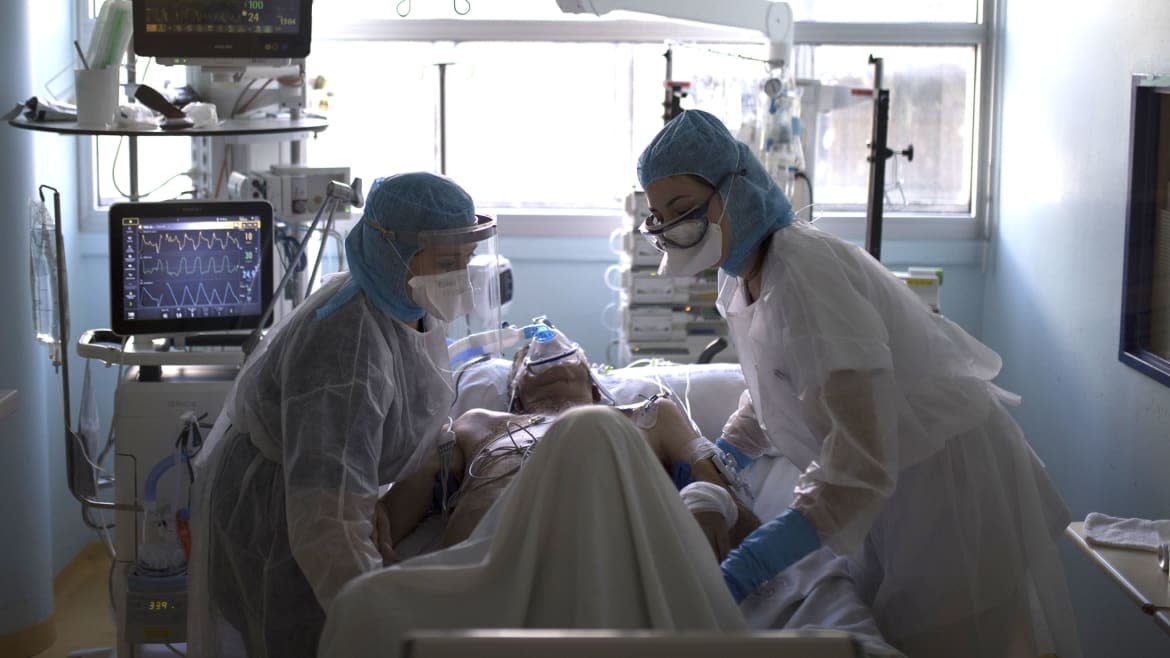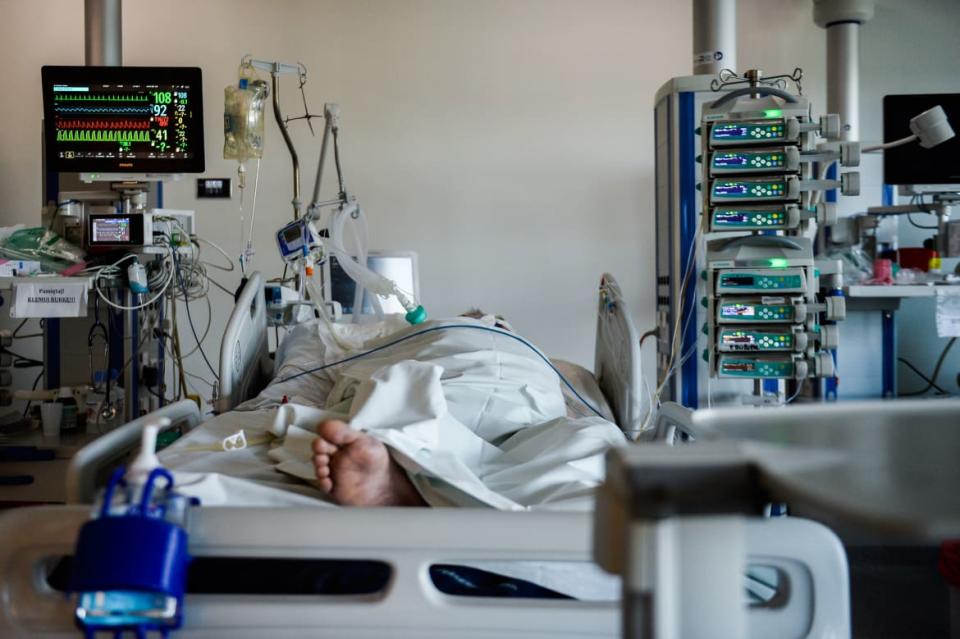The Next Coronavirus Nightmare Is What Happens After the ICU

When Janet Mendez first got off the ventilator, she had no idea who she was.
“[The hospital staff] kept calling me Maria,” she told The Daily Beast. “I said, OK, that’s my name.’”
Except, of course, it wasn’t. Maria is her mother, who had been anxiously calling Mount Sinai in upper Manhattan every day since her 33-year-old daughter was hospitalized with COVID-19. Somewhere along the way, the staff had misplaced Mendez’s ID tag—maybe they’d never given her one at all—and mixed up her name with her mother’s. After 10 days in the intensive care unit, Mendez was too confused to correct them.
Mendez is one of the lucky ones—part of the minority of novel coronavirus patients who require mechanical breathing and still make it out of the hospital alive. She is recovering quickly, and one Mount Sinai doctor described her as a “success.” But for many patients like her, getting out of the ICU is only half the battle.
“There’s surviving and there's returning to your normal life,” Mekeleya Yimen, a critical care physician at Mount Sinai, told The Daily Beast. “That’s not always possible.”
A Coronavirus ICU Nurse on ‘Dying Alone Behind Sliding Glass Doors’
Decades of research shows many of the sickest ICU patients will never return to their former selves. An ailment called Post-Intensive Care Syndrome (PICS) causes cognitive, physical, and psychological problems in up to 80 percent of all critical-care survivors. About a third never return to work.
Now physicians say they are witnessing many of these effects in COVID-19 survivors, at a scale they’ve never seen before. And some are not sure we’re ready for the influx of ICU survivors this crisis will bring.
“I believe and I feel this with every part of me, that the same way there's been a surge in need for hospital beds, there's going to be a surge in need for rehab beds,” said Miguel Escalón, the vice chair of the rehabilitation department at Mount Sinai. “The question is, how will the system step up to meet this?”
Of the hundreds of thousands of Americans projected to contract the coronavirus, a small percentage will require hospitalization. An even smaller percentage will require care in the ICU—often because of a lung condition called acute respiratory distress syndrome (ARDS). Many of them will require mechanical breathing devices called ventilators to keep them alive.
The confusion Mendez felt coming off of the ventilator is common for patients with extended ICU stays—so common it has a name: “ICU delirium.” The extreme stress of critical illness on the body, combined with the sedative drugs and the foreign surroundings of the ICU, leave many people feeling confused and disoriented, occasionally plagued by memories of things that never happened.
Mendez says she spent 10 days on the ventilator thinking she was a character in the Netflix show On My Block. Her imagined exploits on the “show” felt real, but everything happening in real life felt like a dream. When she finally came to, the hospital wing was covered in Christmas decorations. She assumed she’d been in a coma for almost a year, until a nurse told her they were only an April Fools prank.
According to the Society of Critical Care Medicine, between 30 and 80 percent of ICU survivors struggle with some sort of cognitive impairment after their stay. A year after being released from the ICU, a third of patients have cognitive test scores consistent with someone who suffered a traumatic brain injury, like a car crash. A quarter have test scores in the range of mild Alzheimer’s.
Others will suffer from lasting mental health effects. Almost a third of all ICU survivors show clinically important symptoms of depression, and a quarter show signs of Post-Traumatic Stress Disorder—nightmares, flashbacks, fear of going back to the doctor. A study of ARDS survivors found that a third were never able to return to work.
“We talk about physical cognitive and mental health, but it becomes very understandable to everyone when you talk about not returning to work and the lost income,” said Dale Needham, medical director of the critical care and rehabilitation program at Johns Hopkins Hospital. “The impact that this has not just on the patient but their entire family is profound.”
While it’s too early to know the lasting effects of COVID-19 on survivors, doctors told The Daily Beast these patients often awoke confused and disoriented, with no idea what happened to them. Benjamin Seidel, a rehabilitation physician at Burke Hospital in New York, said some of his patients had noticeably different MRI results compared to when they were admitted.
"Some of these COVID patients that we see, if I get my neurologic expert therapist to evaluate them, they say, ‘This person must have had a brain injury,’” said Kyle Ridgeway, an inpatient acute physical therapist at University of Colorado Hospital. For those who have been in the ICU for weeks, he said, “this is going to be a life-altering situation for them.”
Generally, the level of impairment depends on how healthy the patient was before they entered the ICU and how long they had to stay there. But some coronavirus patients who were not admitted to the ICU still show signs of severe mental distress, according Sean Smith, a rehabilitation physician at the University of Michigan.
“A lot of these patients are pretty mentally shaken up,” he said. “I think [overarching] all of this is going to be some element of PTSD for the patients—and for the doctors—who were in the emergency rooms and ICUs.”
For Mendez, the cognitive issues ended mercifully fast. A born-and-bred New Yorker, she said she remembered her name as soon as someone reminded her what street she was on. “The minute they told me it was 114th, I said, ‘Hey I’m close to the house!’” she recalled. Later, she entertained herself and stayed sharp by counting, multiplying and dividing the ceiling tiles above her bed.
But regaining her physical bearings was another story. A formerly healthy 33-year-old, Mendez could not even sit up on her own when she first woke up. Her first task—moving from her bed to a chair—made her feel dizzy and required an oxygen mask. It took her four days to muster the strength to walk to the bathroom on her own; even then, using it on her own was beyond her ability. She took a three-hour nap the first time she tried.

Janet Mendez suffered from ICU delirium after being disconnected from the ventilator.
The experience tracks with what many physicians have seen in their post-ICU coronavirus patients. Every doctor who spoke with The Daily Beast said their patients showed significant muscle loss, reduced lung capacity, and decreased endurance. Some of the most severe patients suffered a temporary paralysis called neuropathy in their hands, feet or limbs.
Ridgeway said what struck him about COVID-19 patients compared to other ARDS survivors was their profound exhaustion. Some of his more muscular patients still struggled to stand for more than 30 seconds without getting fatigued.
“Not an insignificant proportion of them really do feel—even if their oxygen is stable—they just feel profoundly short of breath, especially if they're trying to exert,” he said. “And for some of these patients, ‘trying to exert’ is sitting up to the side of the bed.”
While most of the coronavirus patients who require rehabilitation are older, Ridgeway said he had treated patients in their thirties and forties, some of whom were unable to walk when they entered his care. Heidi Engel, an intensive care physical therapist at the University of San Francisco, described a man in his fifties who caught the virus while on an active outdoors vacation. It took the man a week to relearn how to walk—a progression Engel described as surprisingly fast.
For many of these patients, there is a psychological burden in suddenly waking up with a body that cannot do what it used to. Engel said she’d seen several patients try to walk and fall, forgetting that their legs could not support them.
“I spend a lot of time explaining to people, ‘You have this new body you’re inheriting,’” she said. “‘You’re a fragmented person, and you need to now start to bring all these fragmented pieces back together.’”

Between 30 and 80 percent of ICU survivors struggle with some sort of cognitive impairment after their stay.
Bringing these patients back together is hard to begin with, and even harder when they’re on the heels of a highly contagious virus. Responsible disease prevention requires limiting how many people are exposed to the patient, meaning therapists sometimes don’t get in the room with their patients at all. Ridgeway said he’d started treating some patients through a window in the hospital, with a nurse inside the room to help the patient move.
At Burke, Seidel said they are no longer using shared equipment like treadmills with COVID-positive patients, instead making due with whatever props can be left in the patient's room. When a therapist does make it into the room, they are decked out in head-to-toe personal protective equipment, which makes hands-on treatment difficult. “When you’re basically wearing a hazmat suit it becomes a little more difficult to do some of the therapies,” he said.
At some hospitals in New York City, the epicenter of the disease, inpatient rehab floors have been entirely repurposed into beds for coronavirus patients. At Mount Sinai, rehabilitation doctors are making rounds as general medicine doctors. And at NYU Langone, a rehab physician said he was sending patients home sooner than he’d like, simply because the hospital was not considered safe.
The constraints left a number of doctors worried about how their patients would fare long-term.
“The focus has shifted from usual care to emergency care, meaning things like physical therapy and rehabilitation are taking a back seat, rightfully so, to oxygen status and things like that,” said Smith from the University of Michigan. “But you suffer when you do that. There are patients that aren’t going to get out of bed.”
Still, most of the doctors agreed they hadn't seen the worst of the crisis yet. That will come after the surge in hospitalizations has flattened, and more recovered patients start flooding rehabilitation centers and floors. In New York, where hospitalizations have fallen in the last few days, that could be coming sooner rather than later.
Long-term rehabilitation centers in the state, which take patients who are ready to leave the hospital but not strong enough to go home, are already struggling with the same constraints as major hospitals. Brian Im, a rehabilitation doctor at NYU Langone, said some long-term centers are running with limited personal protective gear and less than half the usual number of staff, making him think twice about where to send his patients.
“You have an already stretched-thin system now reduced beyond that,” he said. “You can just see the safety and the ability to care for patients is severely limited.”
At the same time, home health aides are reluctant to visit former coronavirus patients in their houses, and many outpatient physical therapy clinics are closed for the foreseeable future. Even after the pandemic ends, the national shortage in home-care workers and physical therapists could make it difficult to treat everyone who needs help.
Needham, who has studied PICS for years at Johns Hopkins, said many of these workers will have to be trained in how to treat critical illness survivors, rather than the survivors of heart attacks or brain injuries they are used to.
“Because of COVID, we now have this massive influx of critically ill patients,” he said. “We need to think about the survivorship wave we’re going to face.”
Mendez appears to be on her way to a full recovery. When she finally made it home, it was in an ambulance. After 10 days of recuperation in the hospital, she still cannot get around without a walker. The hospital had to send her home in an ambulance because she couldn’t manage the subway stairs..
Mendez said she plans to return to work as an office administrator at Dominos when she can walk on her own, but doesn’t know when that will be.
“It took a toll on my body,” she said of the virus. “Right now, I'm like a newborn trying to walk again.”
For some reason, Mendez still hasn’t regained her sense of taste—a bitter pill for the daughter of a chef, who has a passion for Italian food. She’s also struggling with another problem: her hair. After nearly a month of not showering in the hospital, it took her two hours at home to get knots out of her curls. At this point, she’s thinking of cutting it all off and starting again.
"I'm in quarantine anyway,” she said. “Nobody’s going to see me.”
Get our top stories in your inbox every day. Sign up now!
Daily Beast Membership: Beast Inside goes deeper on the stories that matter to you. Learn more.

